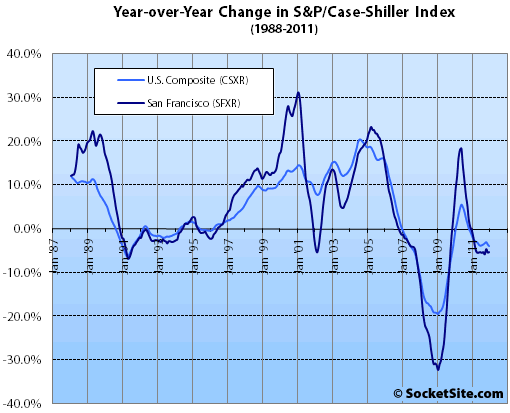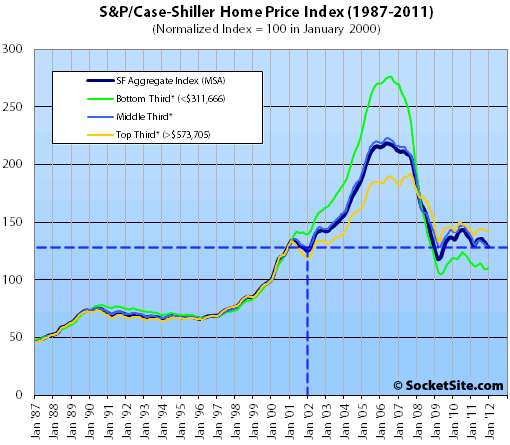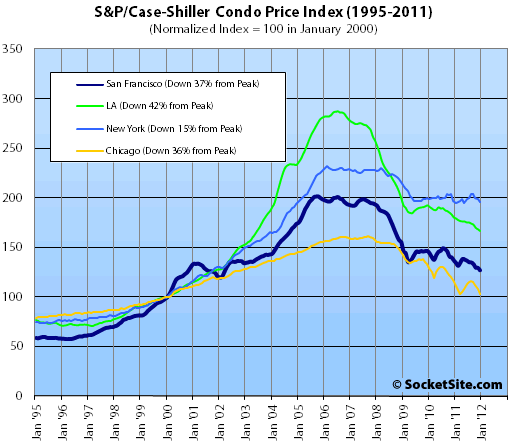
According to the December 2011 S&P/Case-Shiller Home Price Index, single-family home prices in the San Francisco MSA fell 0.8% from November ’11 to December ’11, down 5.4% year-over-year, down 41.1% from a peak in May 2006.
For the broader 10-City composite (CSXR), home values fell 1.3% from November to December, down 3.9% year-over-year, down 33.8% from a June 2006 peak.
With this month’s report we saw all three composite hit new record lows. While we thought we saw some signs of stabilization in the middle of 2011, it appears that neither the economy nor consumer confidence was strong enough to move the market in a positive direction as the year ended.
After a prior three years of accelerated decline, the past two years has been a story of a housing market that is bottoming out but has not yet stabilized. Up until today’s report we had believed the crisis lows for the composites were behind us, with the 10-City Composite originally hitting a low in April 2009 and the 20-City Composite in March 2011. Now it looks like neither was the case, as both hit new record lows in December 2011. The National Composite fell by 3.8% in the fourth quarter alone, and is down 33.8% from its 2nd quarter 2006 peak. It also recorded a new record low.
In general, most of the regions also posted weak data in December. Eighteen of the cities saw average home prices fall in December over November. Seventeen of the cities have seen monthly declines for at least three consecutive months. In addition to both monthly composites, 10 of the cities saw home prices fall by more than 1.0% during the month of December. The pick-up in the economy has simply not been strong enough to keep home prices stabilized. If anything it looks like we might have reentered a period of decline as we begin 2012.
On a month-over-month basis, prices were up for the bottom third of San Francisco price tiers, up nominally for the middle, down nominally at the top.

The bottom third (under $311,666 at the time of acquisition) rose 0.9% from November to December (down 4.6% YOY); the middle third rose 0.3% from November to December (down 7.1% YOY); and the top third (over $573,705 at the time of acquisition) fell 0.4% from November to December, down 1.4% year-over-year (versus a 1.9% in November).
According to the Index, single-family home values for the bottom third of the market in the San Francisco MSA have dropped to May 2000 levels having fallen 60% from a peak in August 2006, the middle third has dropped below March 2002 levels having fallen 42% from a peak in May 2006, and the top third has dropped to January 2004 levels having fallen 26% from a peak in August 2007.
Condo values in the San Francisco MSA fell 1.9% from November ’11 to December ’11, down 7.3% year-over-year, down 37.0% from a December 2005 peak.

Our standard SocketSite S&P/Case-Shiller footnote: The S&P/Case-Shiller home price indices include San Francisco, San Mateo, Marin, Contra Costa, and Alameda in the “San Francisco” index (i.e., greater MSA) and are imperfect in factoring out changes in property values due to improvements versus appreciation (although they try their best).
∙ Case-Shiller: All Three Home Price Composites End 2011 at New Lows [Standard & Poor’s]
∙ S&P/Case-Shiller San Francisco: Homes Dip, Condos Slip In November [SocketSite]
“down 41.1% from a peak in May 2006.”
Predicting a fall of 50%? That’s just crazy! How could I have been so wrong?
😉
open houses are busy, things are all moving into contract extremely quickly, interest rates at all-time lows.. it doesn’t seem as grim as this report makes it sound.
“Predicting a fall of 50%? That’s just crazy! How could I have been so wrong”
But you didn’t keep it to CS-MSA.
Great news!
“But you didn’t keep it to CS-MSA.”
Correct! Never fear flujie, I would never deny you your moment.
But you can’t deny that I was more right than the, “house prices never go down” set.
Yes I can with the aid of hindsight. For just about all of SF, zero is looking a lot more correct than 50.
“For just about all of SF”
You bet! As long as “just about all” excludes all the areas that have gone down. District 10 anyone?
“Yes I can with the aid of hindsight. For just about all of SF, zero is looking a lot more correct than 50.”
Errrrr
Tie at -25% sooo I’m calling this a tie
Every single SF -50% is no way no how
SF average -25% ….. Could be. Surely near there.
^As if that fact wasn’t pointed out ad nauseum during the entirety of these back and forths?
err, that was @ diemos.
Diemos, you claimed that SF itself (not the MSA) would have 50% off.
Sorry, but your prediction, so far, remains woefully inaccurate.
So Case Shiller shows SF area prices at 2002 levels overall and top tier prices at 2004 levels. Yeah, SF is WAY different, at about 2003 or 2004 prices. Not even close! And gee, the nationwide figures are back to 2002 levels. SF really is WAY “different.” LOL!
SF is different becuase house get developed and sold for much more than purchase price, they aren’t apple so they don’t get counted. For example the SS posts of:
2.8M Dream House
65 Mountain Spring
123 Laidley
all sold in December, they would have been in the SF proxy top third if they were counted, but they weren’t.
“SF is different becuase house get developed and sold for much more than purchase price, they aren’t apple so they don’t get counted. ”
Errrrr??
Confusedness?
Outside SF developed houses get sold for less than purchase price?
Case Shiller counts re-developed houses differently in SF??
sparky-b, what, in your estimation, is the ratio of improved homes vs. unimproved home resales? Do you think it’s over fifty percent?
I’m asking sincerely, I don’t really have a good idea. And I realize that in some neighborhoods (“The Real SF”) more properties come to market after a remodel than others.
Of course socketsite is going to post the homes that have had wild remodels, floors added and expansions, because that draws page views from people interested in remodels.
Outside SF developed houses get sold for less than purchase price?
If there is a big difference between sale price and next sale price it is not used for case shiller. CS is apples. Lots of SF sales are not apples. Long holds with big price differences aren’t but no work wouldn’t be counted either. SF (’cause it’s in CA) has more of that as well.
Case Shiller counts re-developed houses differently in SF??
No they count them the same everywhere = not at all. The are done more often in SF than they are done elsewhere, so more high priced SF sales are not counted compared to other areas.
I just glances through D5 and there are 50 houses for sale; 17 of them seem to have had a lot of work done.
Last Sunday I went to the only two sfh’s on Russian Hill and Telegraph Hill, one for 2.75m, one for 3m, both 2 bedrooms. They looked good, but funky layout, with every square foot maximized.
There’s very little inventory in sfh and prices are sky high. When I go out to look at what is actually for sale, I just don’t see the price declines that these graphs show.
That is because those are total remodels and are not reflected in this chart.
SF is different becuase house get developed and sold for much more than purchase price, they aren’t apple so they don’t get counted.
As they shouldn’t. There’s a big difference between measuring market appreciation versus changes in values, or prices, as a result of an investment in the asset.
That’s exactly why changes in median shouldn’t be confused with changes in values, although they all too often are, and even price per square foot trends get influenced by changes in mix.
I like the trajectory of the condo chart. A little hard to tell, but it looks like the SF condo index is breaking down to new lows for the cycle? Hope it continues down!
My 2007 purchased condo in SB was appraised for more rhan i paid due to a comp. I did a refi at low rate. Meanwhile renters in newer non rent controlled buildingd are getting rent increase notices above 10%.
On the other hand Case Shiller also doesn’t measure depreciation in terms of the actual physical state, systemic performance, or looks of a home. A lot of those 2004-2005 trades were remodelled even earlier. So we’re talking about a decade of wear and tear — not to mention stylistic changes — in some cases.
41.1% down from peak is still enormously expensive–just saying
Shouldn’t the study account for house wear and tear? A house is a depreciating asset, after all
I should know better by now to even bother commenting on the C/S index thread and now I am done for good. Median, mix, old link, blah, blah, blah.
I bought a house in 2001 for $2 million that appreciated to $3 million by 2006 so I was up 50%. Since then, it’s come back off to $2 million, so I’m down 33.3%. So if I round, that leaves me up 17%– that’s fantastic!!.
More interesting to me is where we are going from here.
I am thinking the market is going to “improve” to the point where we stop seeing nominal declines in prices. I don’t expect any uptick, at least not in the C-S SF MSA index. We have been building at less than demand for a long time so we should be working through most of the overhang.
I know the banks have some inventory that they held back on foreclosing on while the robosigning mess got sorted out, so that could put some downward pressure on prices.
But with the economy modestly improving and borrowing costs still so low, I think it will work out to a draw.
What do others think?
I still find it fascinating that in the prior two downturns the top-tier (“RealSF”) fared the worst this time the lower tiers are doing worse.
I’m not just talking since peak either. If we take a look at the second leg of the double-dip (since Jan ’10) the upper end has only fallen 2% while the mid tier is down 9% and the low tier is down 7%.
What changed? Is it really different this time, or is an upper-end collapse inevitable?
NVJ,
If banks are given the time they need to mend their books, they’ll keep trickling some property over the next decade. If they need liquidity, that’s another story. But I am speaking nationally. SF should have enough unsatisfied demand to absorb distressed property I think.
What I hope is that short term speculators will be chasing something else now. If this is the case then RE will be back to be the good old boring family purchase it has mostly been. Mortgage, 30 years, your payments get easier and easier with time, at 40 you can focus your income on your kids and then building retirement. The house is a bonus that you will give your kids if/when they want it.
I hope the next generation will understand that because ours messed up big time 😉